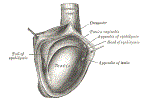II. Anatomy
- Testicular size (length)
- Images
 Lewis (1918) Gray's Anatomy 20th ed (in public domain at Yahoo or BartleBy)
Lewis (1918) Gray's Anatomy 20th ed (in public domain at Yahoo or BartleBy) Lewis (1918) Gray's Anatomy 20th ed (in public domain at Yahoo or BartleBy)
Lewis (1918) Gray's Anatomy 20th ed (in public domain at Yahoo or BartleBy)
III. Physiology: Development
- Gestation 5.5 to 8 weeks
- Gonadal differentiation is triggered by Testis determining factor Protein (SRY gene)
- Primordial gonad differentiates into Testicle
- Testes develop from mesenchymal tissue within urogenital ridge (gonadal ridge)
- Gonadal agenesis occurs if primordial germ cells fail to migrate into urogenital ridge
- Gonadal differentiation is triggered by Testis determining factor Protein (SRY gene)
- Gestation 8 to 15 weeks
- Transabdominal migration of Testicle from gonadal ridge to lumbosacral region of developing Kidney
- Testicles migrate to the inguinal ring as the cranial suspensory ligament regresses
- Gestation 10 to 11 weeks: Androgen secretion
- Leydig cells produce Testosterone and Insulin-like peptide 3
- Wolffian duct (Mesonephric duct) differentiation
- Epididymis
- Vas deferens
- Seminal Vesicles
- Gestation 32-36: Testes descend into Scrotum
IV. Physiology: Function
-
Pituitary Gland
- Releases Luteinizing Hormone (LH)
- Testes
- Leydig cells in Testes releases Testosterone in response to LH release
